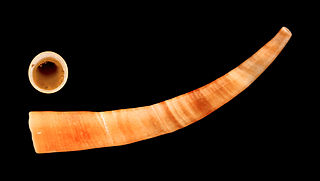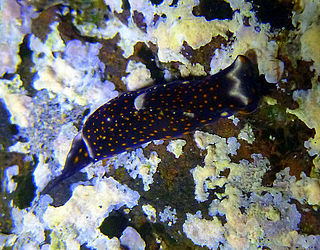Related Research Articles

Squid are cephalopods in the superorder Decapodiformes with elongated bodies, large eyes, eight arms and two tentacles. Like all other cephalopods, squid have a distinct head, bilateral symmetry, and a mantle. They are mainly soft-bodied, like octopuses, but have a small internal skeleton in the form of a rod-like gladius or pen, made of chitin.

Sea slug is a common name for some marine invertebrates with varying levels of resemblance to terrestrial slugs. Most creatures known as sea slugs are actually gastropods, i.e. they are sea snails that over evolutionary time have either completely lost their shells, or have seemingly lost their shells due to having a greatly reduced or internal shell. The name "sea slug" is most often applied to nudibranchs, as well as to a paraphyletic set of other marine gastropods without obvious shells.

The mantle is a significant part of the anatomy of molluscs: it is the dorsal body wall which covers the visceral mass and usually protrudes in the form of flaps well beyond the visceral mass itself.

The tusk shells or tooth shells, technically the Scaphopoda, are members of a class of shelled marine mollusc with worldwide distribution, and are the only class of exclusively infaunal marine molluscs. Shells of species within this class range from about 0.5 to 15 cm in length. Members of the order Dentaliida tend to be significantly larger than those of the order Gadilida.

Limax maximus, known by the common names great grey slug and leopard slug, is a species of slug in the family Limacidae, the keeled slugs. It is among the largest keeled slugs, Limax cinereoniger being the largest.
Torsion is a gastropod synapomorphy which occurs in all gastropods during larval development. Torsion is the rotation of the visceral mass, mantle, and shell 180˚ with respect to the head and foot of the gastropod. This rotation brings the mantle cavity and the anus to an anterior position above the head.

Fiona pinnata, common name Fiona, is a species of small pelagic nudibranch, a marine gastropod mollusk in the superfamily Fionoidea. This nudibranch species lives worldwide on floating objects on seas, and feeds mainly on barnacles, specifically goose barnacles in the genus Lepas.

Crepidula adunca, common name the "hooked slippersnail" is a species of sea snail or "slipper snail", a marine gastropod mollusk in the family Calyptraeidae, the slipper snails and cup-and-saucer snails.

Pseudunela cornuta is a species of minute sea slug, an acochlidian, a shell-less marine and temporarily brackish gastropod mollusk in the family Pseudunelidae. Adults are about 3 mm long and live in the spaces between sand grains.
Onchidiopsis corys is a species of small sea snail with a transparent internal shell, a marine gastropod mollusk in the family Velutinidae. Because the shell is mostly internal, the snail resembles a sea slug in general appearance.
Aiteng ater is a species of sea slug, a marine gastropod mollusc in the family Aitengidae. The specific name ater is from the Latin language and means black, in reference to the appearance of the slug on the mud.

Pseudunela viatoris is a species of sea slug, an acochlidian, a shell-less marine gastropod mollusk in the family Pseudunelidae.

Pseudunela marteli is a species of sea slug, an acochlidian, a shell-less marine gastropod mollusk in the family Pseudunelidae.
Bathyacmaea secunda is a species of very small, deep-sea limpet, a marine gastropod mollusk in the family Pectinodontidae. This species inhabits the dark, chemosynthesis-based marine communities of ocean vents and cold seeps near Japan.

Berghia stephanieae is a species of sea slug, an aeolid nudibranch. It is a marine gastropod mollusc in the family Aeolidiidae. It was previously known as Aeolidiella stephanieae.
Chromodoris tenuis is a species of colourful sea slug, a marine gastropod mollusk, a nudibranch in the family Chromodorididae. The scientific name of the species was first published in 1881 by Collingwood.

Diaphorodoris mitsuii is a species of sea slug, a dorid nudibranch, a shell-less marine gastropod mollusc in the family Calycidorididae.

Biuve fulvipunctata, the white-speckled headshield slug, is a species of sea slug or headshield slug, a marine opisthobranch gastropod mollusc in the family Aglajidae. This species is widespread in the Indian and Pacific Oceans but has invaded the Mediterranean Sea since 1961, despite apparently being absent from the Red Sea until recorded there in the 21st century. It is the only species in the monotypic genus Biuve.

Bathyhedyle boucheti is a species of panpulmonate slug, a deep-sea dwelling gastropod native to the continental slope off the coast of Mozambique. It is the first ever such panpulmonate slug to be discovered at such depths. It is the only known member of its family group. Its radular formula is 1.1.2.
Janolus flavoanulatus is a sea slug species. The specific name is derived from Latin words flavus (“yellow”) and anulatus (“ringed”). These soft-bodied mollusks are known for their extraordinary colors and prominent forms. The first description of this species was reported by researcher Terry Gosliner, a leading researcher in the evolutionary history of nudibranchs. Upon his conducted research in the Philippines, Gosliner named Janolus flavoanulatus for its yellow ring around its cerata.
References
- 1 2 3 4 5 6 7 8 9 10 11 12 13 14 15 16 17 18 19 20 21 22 23 24 25 Schrödl M. & Neusser T. P. (2010). "Towards a phylogeny and evolution of Acochlidia (Mollusca: Gastropoda: Opisthobranchia)". Zoological Journal of the Linnean Society 158: 124-154. doi:10.1111/j.1096-3642.2009.00544.x.
- ↑ Challis (1968). Trans. R. Soc. N. Z. (Zool.) 10: 193.